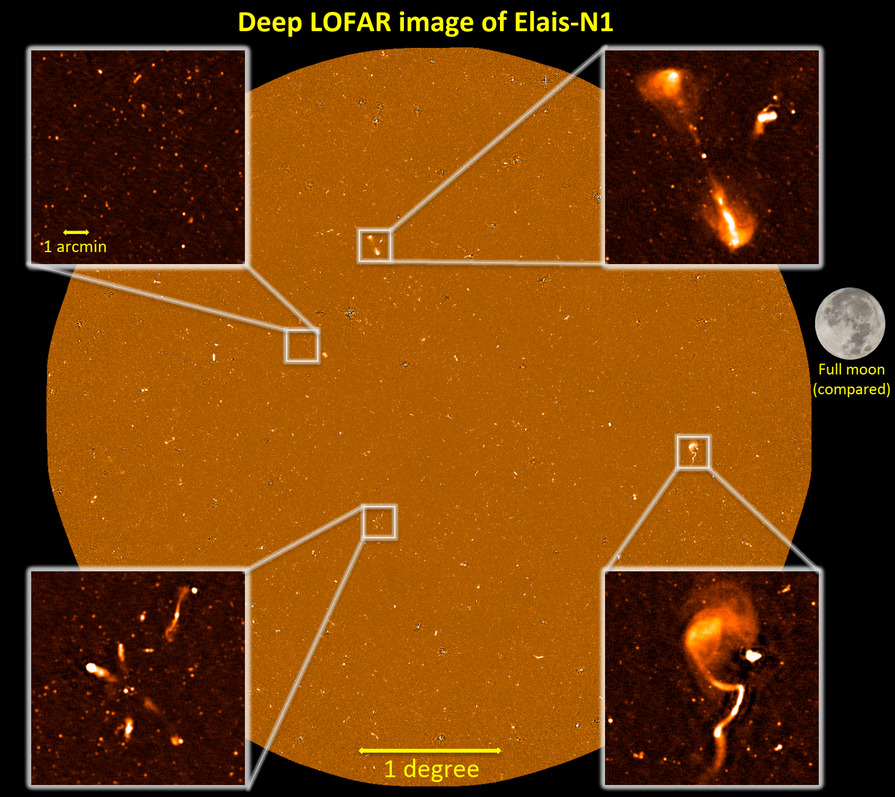Astronomy Object of the Month: 2021, May
< previous Archive next >
LOFAR and the galaxies of the young Universe
International team of astronomers, including scientists from the Astronomical Observatory of the Jagiellonian
University, has published the most accurate map of the Universe at low radio frequencies, created with the use
of the European LOFAR radio telescope. As a result, it was possible to detect the faint radio glow from the stars
that exploded as supernovae in tens of thousands of ancient galaxies spread out to the farthest regions of the Universe.

Illustration:
The deepest LOFAR image showing the Elais-N1 region of the sky. The map was obtained by observing the same
part of the sky for a total of 164 hours. Over 80,000 astronomical radio sources have been detected, including
objects with strong emissions from massive black holes and distant galaxies similar to our Milky Way in which
stars are still forming. Credit: The Authors.
In the past, radio telescopes were aimed mainly at the strong radio sources of our sky, including the Milky Way
or massive black holes located in the centers of large and nearby active galaxies. However, the new map obtained
with the LOFAR interferometer is different - so deep that most of the visible objects are galaxies similar to the
ours, but observed at the time when their stars and themselves were just forming. From our point of view, many of
them lies on the edge of the known Cosmos.
Astronomers know that star formation usually occurs in the clouds of dust that effectively obscure our view of the stellar birth process in visible light. However, radio waves penetrate the dust much more easily. Thanks to this, with the help of the LOFAR telescope, scientists were able to recreate the full picture of the star formation in ancient galaxies. Moreover, these accurate observational data enable precise determination of the relationship between the brightness of galaxies at radio waves and the rate of new star formation in them, which in turn allows for a more accurate assessment of the number of new stars forming in the young Universe.
LOFAR observed three rejons of the northern sky containing thousands of ancient galaxies (LOFAR antennas, due to their location in Europe, can "see" the northern part of the celestial sphere). The selected areas are so-called cosmic "deep fields", named Elais-N1, Boötes and the Lockman Hole . They have been previously selected for very accurate research in many ranges of the electromagnetic spectrum - from ultraviolet through visible light to far infrared. This enables their comprehensive study and development of the evolutionary scenarios for the distant objects detected in these areas.
Deep fields were observed with LOFAR many times. Then, the recorded data were joined into single maps with long exposure. Such radio images are obtained by processing huge amounts of data. To create these maps, signals from more than 70,000 individual antennas of the LOFAR interferometer were combined. They made up a total of over 4 petabytes of raw data, which corresponds to one million recorded DVDs.
A large number of Polish astronomers took part in the research of the international team: prof. Krzysztof Chyży, dr Arti Goyal, dr hab. Marek Jamrozy and Dr. Błażej Nikiel-Wroczyński from the Jagiellonian University in Krakow; Dr. hab. Magdalena Kunert-Bajraszewska and Aleksandra Wołowska, MA from the Nicolaus Copernicus University in Toruń; and dr hab. Katarzyna Małek from the National Center for Nuclear Research.
The international LOFAR (LOw Frequency ARray) telescope is a pan-European network of radio antennas, with the core center located in Exloo, the Netherlands. Polish LOFAR stations are managed by the POLFARO group, which includes the owners of three stations: University of Warmia and Mazury in Olsztyn - Bałdy station, Jagiellonian University in Krakow - Łazy station, Space Research Centre of the Polish Academy of Sciences in Warsaw - Borówiec station; and the PCSS - Poznan Supercomputing and Networking Center.
Original publication: A special edition of the scientific journal "Astronomy and Astrophysics" is devoted to fourteen research papers describing the method of creating maps and the first scientific results.
The research was conducted at the Department of Radioastronomy and Space Physics and Stellar and Extragalactic Astronomy of the Jagiellonian University’s Astronomical Observatory (OA UJ). This work was supported by the Polish National Science Centre through the grants 2018/29/B/ST9/02298 and 2018/29/B/ST9/01793. The maintenance of Polish LOFAR stations is financed by the Ministry of Education and Science.
|
Elżbieta Kuligowska Astronomical Observatory Jagiellonian University E.Kuligowska [at] uj.edu.pl |
Krzysztof Chyży Astronomical Observatory Jagiellonian University K.Chyzy [at] oa.uj.edu.pl |


